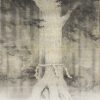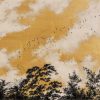OPEN DAY : Friday 26 June 2020 from 12 pm to 8 pm
The artist will be present
as part of ARTEAM CUP GENOVA Arte in Centro, 27 June – 25 July 2020
Location: VisionQuesT 4rosso Piazza Invrea 4 r, 16123 Genova – Italy
Tuesday to Saturday 3 pm – 7 pm and by appointment
Information and e-mail: info@visionquest.it
ARTEAM CUP Focus Genova – Arte in Centro is a collective event that brings together six Genoese galleries with as many Solo exhibitions. The event kicks off on Friday 26 June with an Open Day from 12 pm to 8 pm allowing for the fixed number of entries at a time in the various exhibition venues, in compliance with the anti Covid-19 ministerial protocols.
VisionQuesT 4rosso is pleased to present the works of Shoko OKUMURA from the series FLOATING UNIVERSE.
A profound trait of the soul of Japan lies in the feeling of the passing of things, their fluctuation; seasons passing, colors waning and sounds merging towards a renewed harmony have always, across all cultures, been a source both of art inspiration through its myriad of expressions and of deep emotions for souls open to the world’s wonders.
The Japanese love of nature and its manifestations is well recognized.
This style of painting is more demanding than what appears at first glance. An intent gazer must mesh palpable first impressions with subtle hints and allusions, thereby expanding one’s extrinsic perceptive vision, the image within the frame, to the inner self – of both artist and observer – to whom these image truly appeals
Viana Conti writes: “It is undecidable, at a first visual approach, if the works of the Japanese artist Shoko Okumura, presented on display in Genoa by Clelia Belgrado at VisionQuest 4rosso contemporary photography, are photographs or pictorial-calligraphy and therefore responding to the traditional oriental technique called Nihonga (日本 画, Japanese style painting). A thousand-year-old technique, adapted to the implementation of a formal language, the use of particular materials and the representation of subjects belonging to oriental culture. These paintings, from monochrome, to black ink, to polychrome, to natural and mineral pigments, whose diluent is always water-based, are made by brush on treated, macerated and hand-blended Japanese paper, or on silk, also using thin sheets gold and silver. Well-known contemporary artists, including Takashi Murakami, have also been trained in the Japanese tradition of Nihonga. In the past, to continue and innovate this tradition, the writer Okakura Tenshin, descended from a samurai family, and the American art historian of Spanish origin Ernest Fenollosa, known and introduced also by texts of the poet Ezra Pound .
Contemplating the works of Shoko Okumura, the observer simultaneously grasps two levels: that of the mimesis of Nature, referring to Japanese artistic conventions, and that of the aesthetic expression of a Pathos, aroused by the changing of the seasons and therefore of flowering, of the fruits, leaves, in parallel with the dynamic perception of light, wind, clouds, reflections on bodies of water. The artist Okumura was born in Japan in 1983, trained in Traditional Japanese Painting at Tokyo University of the Arts, then moved to Florence to study the restoration technique, graduating from the International Art University of the Tuscan capital. Currently the painter-calligrapher lives and works in Milan. It is natural, looking at these works, to ask how an international contemporary artist of oriental culture can continue a remote tradition, so intimately profound, in a globalized context in which the values of identity, belonging, slowness, meditation, memory, they do not cease to be called into question. Her creative attitude conforms to the Japanese aesthetic concept Mono no aware (物 の 哀 れ) marked by a profound perception of the beauty of the Cosmos and Nature, from which flows her emotional participation in the fatal impermanence of natural events, expressed, in heri mmaterial visions of the landscape, in terms of poetry and nostalgia veiled with melancholy. Appreciable is the monochrome pigment, called sumi-e, of the work entitled Waltz in gray / Waltz in gray, in which the sacred Sakura tree turns the symbolic pink color into a pale blue-gray. The cherry blossom, in fact, as festive as it is deciduous, a symbol of physical and spiritual spring, combines the sense of precariousness of existence with that of the taste of the instant, the prospect of rebirth and the purity and readiness to sacrifice the samurai. Even the titles of the works, like their representations suspended on the oneiric threshold, reflect the phenomenological events of the appearance and disappearance, of the stasis and of the movement, of the incessant fading of the conditions of nature in the flow of internal projections. The shadow of an archaic technique returns and become an image of a way of living the impermanence of being beyond temporal boundaries, on the threshold of a third millennium where it is the digital virtuality that floods the gaze of the observer, both in the East as in the West”.
Viana Conti, Marzo 2020
Technique
Pigments silver/gold leaves, Indian Ink on Japanese hand made paper or fabrique
Bio:
Shoko Okumura was born in Chiba, Japan in 1983, she currently lives and works in Milan. She graduated in Traditional Japanese Painting at Tokyo University of the Arts (Tokyo Academy of Fine Arts) in 2008. She received a prestigious scholarship awarded by the Japanese government. Immediately after graduation she moved to Italy to learn the technique of restoration of frescoes at the International University of Art in Florence; Crossing the technique learned with the fresco painting, she learned about the characteristics of the Italian pigments, where she started experimenting by mixing them with the Japanese painting technique, which uses a lot of metal (e.g. silver / gold leaves). Thanks to this experience she became passionate about the result obtained by mixing the two Italian and Japanese techniques. Her main goal is to represent the relationship between nature and man. She has numerous collective and personal exhibitions to her credit both in Italy and abroad.



